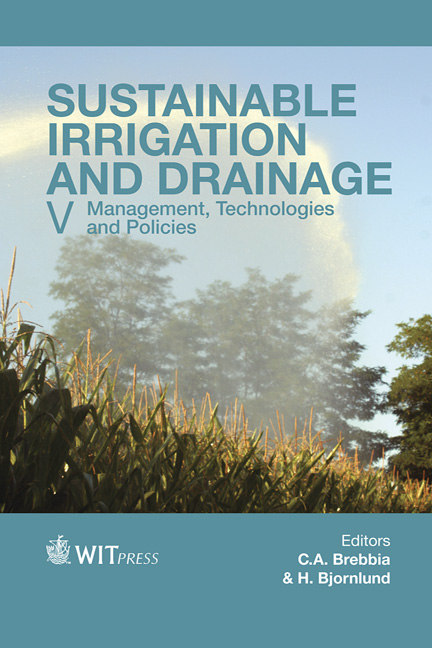Water And Heat Stress: The Effect On The Growth And Yield Of Maize And The Impacts On Irrigation Water
Price
Free (open access)
Transaction
Volume
185
Pages
11
Page Range
77 - 87
Published
2014
Size
1,327 kb
Paper DOI
10.2495/SI140081
Copyright
WIT Press
Author(s)
A. Garcia y Garcia, M. A. Abritta, C. M. T. Soler, A. Green
Abstract
The onset of water stress and the determination of heat stress on maize were studied using a ground-based remote sensing technique. The experiments were conducted at the University of Wyoming Research and Extension Center located in Powell, WY during the 2012 growing season on fields subjected to sub-surface drip irrigation (SDI), on-surface drip irrigation (ODI), and sprinkler (SPR) irrigation methods. In all three experiments the crop was subjected to three irrigation strategies, including 1.00ETc, 0.75ETc and 0.50ETc. Throughout the growing season the canopy temperature was monitored with infrared thermometers (IRTs) and the environmental variables were monitored with an automated weather station that was located on site. The IRTs were set to automatically retrieve and transmit the data to a dedicated computer using data loggers and radio transmitters/receivers. The soil moisture was monitored weekly with a neutron probe to a depth of 1 m. Plant samples for growth analysis were obtained regularly, and phenology observations were recorded bi-weekly. Photosynthesis was obtained in all treatments within each experiment using an infrared gas analyzer. Compared to the ODI and the SPR fields, water and heat stress had less effect on maize grown at the SDI field. Reduction on net photosynthesis was as little as 5.91 percent at the 0.75ET treatment of the SDI to as much as 65 percent at the 0.50ET treatment of the SPR. A functional relationship between the average crop water stress index (CWSI) and grain yield, was found. The use of IRTs for conditions in the semi-arid and arid regions of Wyoming showed to be promising as long as the crop water stress index is kept near zero. Our results are encouraging and of special importance in times of declining water resources being available for crop production as may allow for further development of technologies for irrigation scheduling aiming at enhancing the water use and water productivity of crops.
Keywords
infrared thermometers, ground-based remote sensing, canopy temperature, crop water stress index, CWSI, maize water stress, maize heat stress, limited irrigation





